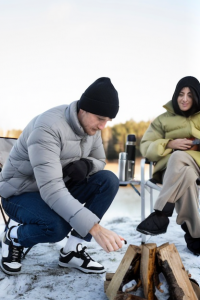News Center+ 查看更多
Essential Gear Selection for Winter Camping+ 查看更多
Layering: The Art of Staying Warm
The art of layering is essential in maintaining core body temperature. A moisture-wicking base layer keeps you dry, a warm mid-layer such as fleece retains heat, and a windproof and waterproof outer layer shields you from the elements. Cotton is infamous for its poor insulation when wet, making it a poor choice for winter expeditions. By dressing in layers, you create an adaptable system that can be modified as activity levels and temperatures change, ensuring comfort throughout your venture into the winter wilderness.
Strategic Tent Setup for Optimal Warmth
The location and setup of your tent can make a significant difference in comfort levels. Selecting a site that receives sunlight and is shielded from wind can reduce the chill. An extra layer of insulation under your tent, such as foam pads or a specialized tent footprint, can prevent heat loss to the ground. This additional barrier can be the difference between a restful sleep and a night spent shivering.
Keeping Dry to Retain Warmth
Moisture is the nemesis of warmth, conducting heat away from the body quickly. Staying dry is crucial in the battle against the cold. Wet clothing, especially gloves, socks, and headwear, should be replaced with dry alternatives at the first sign of dampness. This proactive approach can prevent the discomfort and danger of hypothermia, ensuring that the winter experience remains enjoyable and safe.
Caloric Intake and Hydration: Fuel for Warmth
To wage war against the cold, your body needs fuel. High-calorie foods and warm drinks provide the energy needed to generate body heat. Pre-prepared meals that are easy to heat and drinks like hot tea or chocolate not only satiate hunger but also contribute to overall warmth. Carrying a thermos allows for immediate access to hot liquids, providing both comfort and a heat source from within.
Activity: Generating Heat Through Movement
Movement generates heat, so light activities can be a lifesaver in the cold. Something as simple as a walk can boost body temperature significantly. However, caution should be exercised to avoid sweating, as this introduces moisture and can lead to rapid heat loss. The goal is to strike a balance between activity for warmth and rest to conserve energy.
Preparations Before Sleeping
Before retiring to your sleeping bag, donning clean, dry sleepwear can prevent the chill from sapping warmth. A heated water bottle placed in the sleeping bag acts like a personal radiator, warding off the cold. A few squats or other light exercises can increase your core temperature, ensuring you enter your sleeping bag warm, increasing the chances of a cozy night's sleep.
Ventilation: The Key to a Dry Tent
Even in the depths of winter, a tent needs ventilation to prevent condensation from forming and dripping inside. This balance between keeping warm and ensuring a flow of air to avoid moisture build-up is critical. Without proper ventilation, the inside of the tent can become just as wet as the outside, leading to a damp and cold camping experience.

